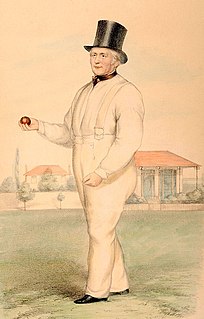Related Research Articles
Henry Jupp was an English first-class cricketer who was active in the 1820s playing for Surrey county cricket teams. He is recorded in two first-class matches. In 1824, he played for Godalming Cricket Club against Marylebone Cricket Club (MCC) at Lord's Cricket Ground, scoring 2 in his sole innings. In 1827, Jupp played for All-England against Sussex at Darnall New Ground in the first of the roundarm trial matches, scoring 0 not out and 20.
1864 was the 78th season of cricket in England since the foundation of Marylebone Cricket Club (MCC). It was a significant year in cricket history, as it saw the legalisation of overarm bowling and the first edition of John Wisden’s Cricketers’ Almanac.
1826 was the 40th season of cricket in England since the foundation of Marylebone Cricket Club (MCC). The revival of inter-county cricket gathered pace and William Clarke made his known first-class debut.
1828 was the 42nd season of cricket in England since the foundation of Marylebone Cricket Club (MCC) who effected a modification of the Laws of Cricket in an attempted compromise re the roundarm issue.

1800 was the 14th season of cricket in England since the foundation of Marylebone Cricket Club (MCC). It is one of the more difficult seasons to analyse because of several matches involving prominent town clubs like Rochester, Woolwich, Homerton, Richmond, Storrington, Montpelier and Thames Ditton.
1817 was the 31st season of cricket in England since the foundation of Marylebone Cricket Club (MCC). Cricket was hit by a controversial match-fixing scandal.
1819 was the 33rd season of cricket in England since the foundation of Marylebone Cricket Club (MCC). The Gentlemen v Players match, previously played in 1806 only, was resurrected.
1820 was the 34th season of cricket in England since the foundation of Marylebone Cricket Club (MCC). Fuller Pilch made his first known appearance at Lord's. 1820 also sees the earliest mention of wicket-keeping gloves.
1822 was the 36th season of cricket in England since the foundation of Marylebone Cricket Club (MCC). John Willes brought the roundarm issue to a head and sacrificed his own career in the process. The outstanding batsman James Saunders made his known first-class debut.
1825 was the 39th season of cricket in England since the foundation of Marylebone Cricket Club (MCC). The pavilion at Lord's was destroyed by fire. Many irreplaceable documents which recorded early cricket matches are believed to have been lost. The impact of this upon cricket's history is that it is only since 1825 that surviving records can be viewed with anything like complete confidence. Inter-county matches are recorded for the first time since 1796. Two of the greatest players of the 19th century, William Lillywhite and Ned Wenman, made their first known appearances in important matches.
1821 was the 35th season of cricket in England since the foundation of Marylebone Cricket Club (MCC). The Gentlemen v Players match was ended in controversial circumstances.
1823 was the 37th season of cricket in England since the foundation of Marylebone Cricket Club (MCC). Henry Bentley issued his Correct Account of all Matches, 1786–1822.
1824 was the 38th season of cricket in England since the foundation of Marylebone Cricket Club (MCC). Gentlemen v Players was an odds game with 14 on the Gentlemen team, but the Players still won by 103 runs.
1835 was the 49th season of cricket in England since the foundation of Marylebone Cricket Club (MCC). Powerless to prevent the use of roundarm bowling, MCC finally amended the Laws of Cricket to make it legal.

Frederick William Lillywhite was an English first-class cricketer during the game's roundarm era. One of the main protagonists in the legalisation of roundarm, he was one of the most successful bowlers of his era. His status is borne out by his nickname: The Nonpareil.
John Tufton was an English cricketer and a Member of Parliament (MP). He was a member of the aristocratic Tufton family that produced the Earls of Thanet and related through his mother to the Sackville family that produced the Dukes of Dorset.
George Thomas Knight was a famous English amateur cricketer. He was a prominent member of Marylebone Cricket Club (MCC) who played a significant part in the introduction and legalisation of roundarm bowling between 1825 and 1835.
Henry James Lloyd was an English amateur cricketer who played first-class cricket from 1815 to 1830. Mainly associated with Marylebone Cricket Club (MCC), he made 34 known appearances in first-class matches. He played for several predominantly amateur teams including the Gentlemen in the Gentlemen v Players series.
1815 was the 29th season of cricket in England since the foundation of Marylebone Cricket Club (MCC). A discernible recovery began as the Napoleonic Wars ended.
Henry Palliser was an English first-class cricketer associated with Marylebone Cricket Club who was active in the 1820s. He is recorded in one match in 1822, totalling 13 runs with a highest score of 10 and holding one catch.
References
- ↑ "James Hopper". CricketArchive. Retrieved 30 March 2013.
- ↑ "Marylebone Cricket Club v Kent, 1822". CricketArchive. Retrieved 9 November 2011.
- ↑ "Kent v Marylebone Cricket Club, 1822". CricketArchive. Archived from the original on 31 May 2015. Retrieved 9 November 2011.
- ↑ "First-Class Matches played by J. Hooper". CricketArchive. Retrieved 9 November 2011.
- ↑ "Kent v Sussex, 1827" . Retrieved 9 November 2011.